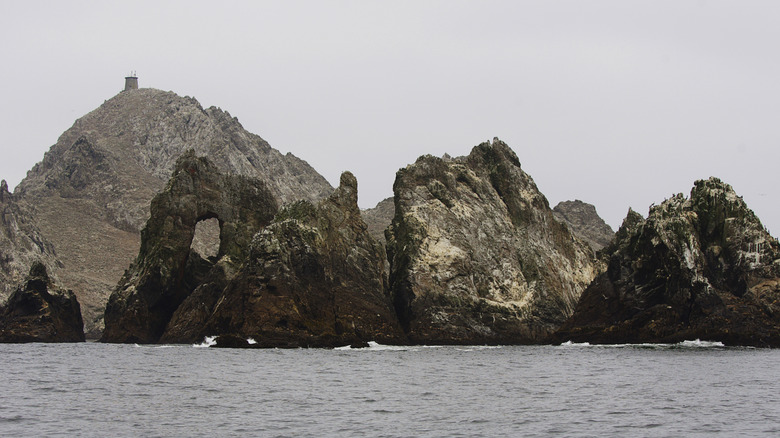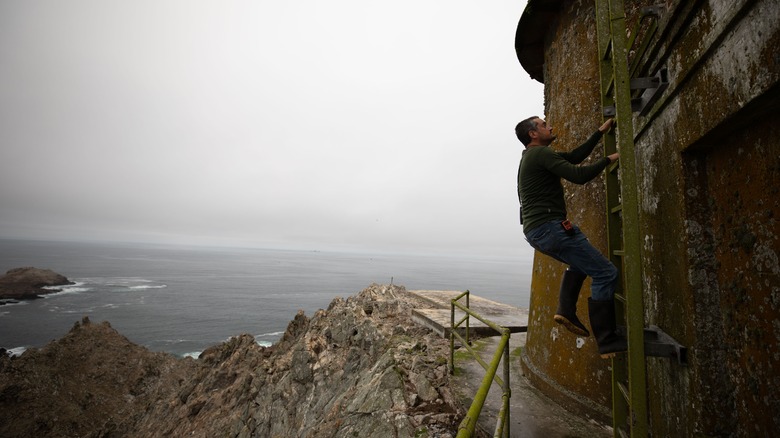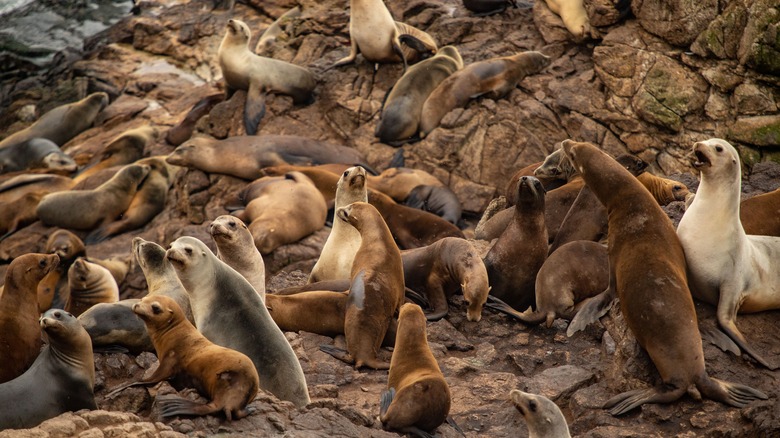The Remote Islands Off The Coast Of San Francisco With A Nickname Befitting Their Danger
"Farallon" sounds like the name a sci-fi villain would give to their secret lair — and the reality behind it isn't so far removed. Just beyond the horizon of San Francisco's Golden Gate Bridge lies an eerie group of rocky islands known as the Farallon Islands. Called the "Devil's Teeth" by mariners and "Islands of the Dead" by the Miwok Native Americans, these craggy outcrops of brutal rock earned their nicknames from the surrounding treacherous waters, haunting landscape, and forbidding reputation as one of the most dangerous islands in the world.
The Farallon Islands are only about 30 miles off the coast of San Francisco, but they may as well be a world away. A cluster of islands and sea stacks ("farallón" means rocky promontory in Spanish), they consist of several small land masses divided into four groups: Southeast Farallon Island (the largest at 70 acres), Middle Farallon, North Farallones, and the rocky outcrop known as "The Noonday Rock." Their jagged, pointed shapes are the source of their fearsome nicknames; from a distance, the islands' sharp, serrated silhouettes resemble the fangs of some great beast.
These islands have long been notorious for their dangers. Sailors in the 19th century dreaded passing by, as the rocks jutting out of the sea created hazardous conditions for navigation through this zone of the Pacific Ocean, especially when shrouded by fog. Shipwrecks were common, with over 400 recorded to this day. From when they were first discovered on an expedition in 1542 until now, the unforgiving nature of the Farallon Islands has kept them remote and largely uninhabited by humans.
Human presence and exploring the Farallon Islands
Human presence on the Farallon Islands is minimal and highly regulated. Southeast Farallon Island was once home to a man-powered lighthouse and a tiny community in the 19th century, but now, the lighthouse is automated, and the original buildings have been converted for research purposes. In the mid-1800s era of San Francisco, the islands served as a hunting ground for valuable seabird eggs, which were collected in large quantities — up to 500,000 per month — to feed the city's growing population. These operations led to conflicts, known as the "Egg Wars," as rival eggers fought for control, sometimes to death. Egging stopped in 1881.
Today, the U.S. Fish and Wildlife Service manages the Farallon Islands National Wildlife Refuge, which was declared a conservation area in 1909 by Theodore Roosevelt. To protect the sensitive ecosystems, access to the islands is permitted only for biologists, maintenance staff, and patrol volunteers, who stay at a small field station to study the ecology and monitor the wildlife.
While the general public is not allowed to set foot on the islands, it is possible to get a glimpse of the Farallons from the water. A handful of eco-tour companies, like the Oceanic Society, offer boat tours that circle the islands. The trips take several hours due to the island's distance from the coast, and the choppy seas and rough weather conditions are not for the faint of heart — an experience that will make it very clear why these islands have earned their "Devil's Teeth" moniker. But for those who do venture out on a tour, the rewards are unforgettable. (Just make sure to curb seasickness with this trick.)
Birds and marine wildlife
Despite their unwelcoming appearance — for humans, that is — these islands are critical habitats for wildlife. For starters, the largest seabird nesting colony in the contiguous United States makes its home here, along with the world's largest colony of western gulls. Over 300,000 seabirds live on the islands, including puffins, murres, and auklets. Seabird breeding season is at its peak from March to August, and it gets deafeningly noisy around this time.
The Farallons are also a haven for marine animals. During the breeding season between December and February, the beaches are crowded with northern elephant seals, sea lions, harbor seals, and fur seals. The islands are particularly famous for white sharks, which come to hunt the seals and other marine life. These apex predators have earned the islands a reputation as one of the best places in the world to see white sharks in action, with a population of approximately 130 around the Farallons, according to a 2014 study. Because the waters are so shark-infested, swimming around this section of the California coast is not recommended.
In addition to sharks, the waters around the Farallons attract gray whales, humpback whales, and blue whales, which migrate through the area between September and November, the best time to go whale watching in Southern California. If you're not planning to make the trek to see the Farallons and its remarkable wildlife in person, you can tune in to the Farallon Islands live webcam, managed by the California Academy of Sciences.


